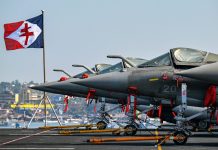In a quiet yet deeply symbolic ceremony at HM Naval Base Devonport, the Royal Navy officially closed a defining chapter in its underwater history.
HMS Triumph, the final operational Trafalgar-class nuclear-powered attack submarine, was formally decommissioned on 21 July 2025, bringing an end to a storied legacy that spanned over four decades.
With her departure, the curtain has now fallen on a class of submarines that not only shaped Britain’s Cold War maritime doctrine but also evolved with remarkable agility to confront the asymmetric challenges of the post-9/11 era.
Known affectionately as “T-boats,” these hunter-killer subs formed the nuclear-powered backbone of Britain’s underwater fleet from the early 1980s onwards, becoming indispensable tools of silent warfare and deterrence.
The Rise Of The T-boats
The Trafalgar class was conceived as a successor to the Swiftsure class, reflecting lessons learned during the tense maritime chess match of the Cold War.
Built by Vickers Shipbuilding and Engineering Limited (VSEL)—now BAE Systems Submarine Solutions—in Barrow-in-Furness, the lead boat, HMS Trafalgar, was ordered in 1977 and entered service in 1983.
Over the next eight years, six more boats joined her: Turbulent, Tireless, Torbay, Trenchant, Talent, and finally Triumph, which was commissioned in 1991.
Each vessel was a formidable fusion of stealth, speed, and striking power. Measuring 85.4 meters in length and displacing 5,298 tons submerged, they were powered by the Rolls-Royce PWR1 nuclear reactor, which drove two General Electric steam turbines and a pump-jet propulsion system.
The boats could achieve submerged speeds of over 30 knots, and were sheathed in anechoic tiles that helped them elude enemy sonar.
They initially carried Spearfish heavyweight torpedoes but had adapted them by the 2000s to launch Tomahawk Land Attack Missiles (TLAMs) through 21-inch torpedo tubes, thereby gaining strategic strike capability deep into enemy territory.
HMS Trafalgar was the first to fire the Tomahawk in April 2008, with other boats quickly following suit.
Designed For Cold War, Tested In Modern Conflict
At their inception, the primary role of the T-boats was clear: shield the UK’s nuclear deterrent, the Trident-armed Vanguard-class SSBNs, from Soviet hunter-killers prowling the North Atlantic. They also conducted clandestine surveillance and intelligence-gathering missions, some of which remain classified to this day.
But as the Soviet Union collapsed, the mission shifted. The Trafalgar class adapted to new roles: covert intelligence, special forces deployment, and precision strike. They weren’t just built for stealth—they were built to evolve.
In 2001, HMS Trafalgar launched Tomahawk missiles during operations in Afghanistan, marking the class’s first combat missile deployment. Triumph joined the fray soon after.
During the 2003 invasion of Iraq, HMS Turbulent launched 30 Tomahawks under Operation Telic, returning to port flying the Jolly Roger, a centuries-old Royal Navy tradition signaling a successful combat mission.
In 2011, HMS Triumph once again made headlines during the NATO-led intervention in Libya, launching six Tomahawks at air defense sites. Her return to Devonport—Jolly Roger flying and six launch marks painted on her sail—cemented her reputation as one of the Royal Navy’s most capable strike submarines.
Engineering Brilliance & Evolving Capabilities
While the outer hull remained similar to the Swiftsure class, the Trafalgar design brought significant improvements.
Reinforced fins and retractable hydroplanes enabled operations under Arctic ice. Internally, they housed the Type 2020 sonar suite, and later upgrades saw several boats, such as Talent and Torbay, fitted with the advanced Type 2076 sonar, now also used in the newer Astute class.
The class was also an early adopter of the Submarine Command System (SMCS), developed by BAE Systems Insyte, later replaced with the SMCS NG in 2008. This next-generation system allowed better integration of sensor data and real-time control over onboard weapons, making the T-boats formidable decision-making nodes in submerged operations.
Notably, HMS Talent showcased experimental features, including wake-detection sensors mounted on either side of the sail—believed to be part of a non-acoustic submarine detection system, possibly meant to trail adversary subs without active sonar emissions.
Global Missions & Records
Though designed for North Atlantic operations, the T-boats often operated far beyond those cold waters. A standout moment occurred in 1993, when HMS Triumph sailed submerged from the UK to Australia, covering 41,000 miles without surfacing —a record-breaking feat for the Royal Navy.
But this versatility came at a cost. By the early 2000s, years of continuous deployments began to take their toll.
In 2000, reports suggested that only Triumph remained fully operational. Refits extended the fleet’s service lives, but issues persisted.
In 2007, a tragic onboard explosion on HMS Tireless during an Arctic patrol killed two weapons engineers, highlighting the inherent dangers of submarine duty.
Decommissioning & Legacy
The Royal Navy began drawing down the Trafalgar class starting with HMS Trafalgar in 2009, followed by Turbulent (2012), Tireless (2014), Torbay (2017), and Talent (2022). Triumph held out the longest, completing a remarkable 34-year career—the longest among her sister boats.
Her decommissioning signals the full transition to the Astute class, of which five are already operational. The next two boats, HMS Agamemnon and HMS Achilles, will soon replace Talent and Triumph, ensuring continuity of Britain’s underwater strike capability.
Looking even further ahead, the SSN-AUKUS program will form the backbone of the Royal Navy’s future SSN fleet. Developed jointly with Australia and the United States, this next-generation design is expected to produce up to 12 new boats starting in the late 2030s, marking the largest expansion of Britain’s attack submarine force in decades.
Meanwhile, the Trafalgar boats enter a new phase—dismantlement. The U.K. has only recently begun the complex process of scrapping its nuclear submarines, with HMS Swiftsure being the first to undergo dismantling.
A Warrior’s Farewell
Despite their quiet retirements, the Trafalgar-class boats leave behind an outsized legacy of deterrence maintained, crises managed, and wars fought from the depths.
Their longevity is a testament to the engineering brilliance behind their design, and the adaptability that allowed them to evolve from Cold War sentinels into 21st-century strike platforms.
The Trafalgar class may now rest, but its legacy will echo through the silent service for decades to come.
- Shubhangi Palve is a defense and aerospace journalist. Before joining the EurAsian Times, she worked for ET Prime. She has over 15 years of extensive experience in the media industry, spanning print, electronic, and online domains.
- Contact the author at shubhapalve (at) gmail.com




